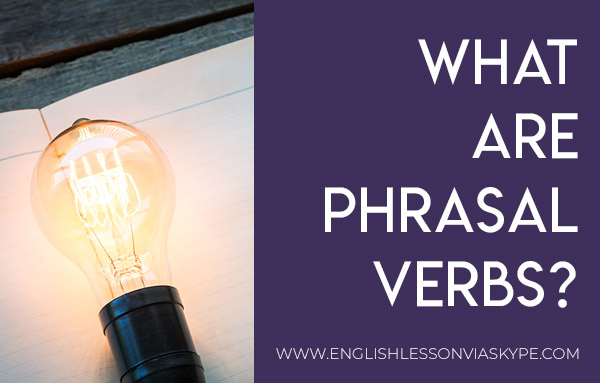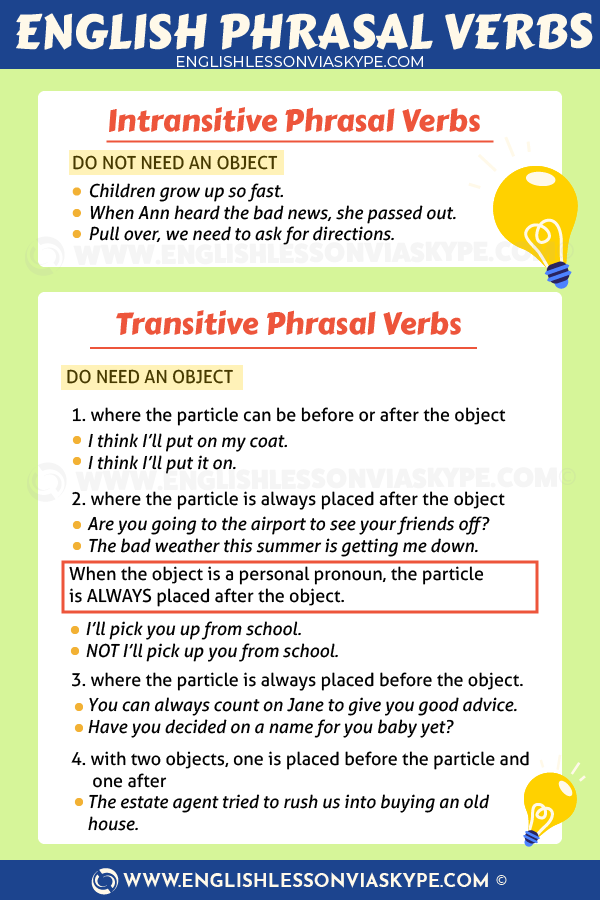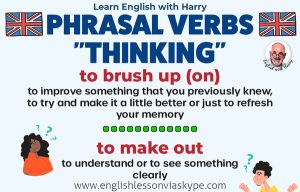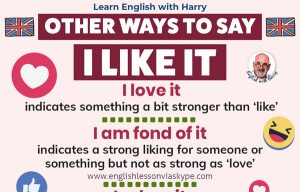Phrasal verbs are very common in everyday English. Learning the definitions of phrasal verbs and understanding the grammar of phrasal verbs are probably the biggest challenges for ESL students.
We often hear from our students that they hate phrasal verbs.
So what are phrasal verbs, and why are they so difficult?

Understanding the Grammar of Phrasal Verbs
Generally phrasal verbs are verbs that consist of two parts.
The first part is always a verb (give, break, cut, get, etc.) and the second part is a particle (a preposition or adverb).
Sometimes phrasal verbs consist of a verb and two particles (an adverb and a preposition). The particle changes the original meaning of the verbs.
Together as a phrase they have a completely different meaning as compared to the verb itself.
The meanings of some phrasal verbs are rather easy to understand. They are still close to the original meaning of the verb. (get up, fall through, sit down)
However, if a phrasal verb is idiomatic, it has a special meaning that we cannot easily guess.
Usually a phrasal verb has a non-phrasal synonym, but this is not always the case.
For example:
To give up = to quit
To set up = to establish
To find out = to discover
Types of Phrasal Verbs
There are five main types of phrasal verbs. These are:
INTRANSITIVE PHRASAL VERBS
Intransitive phrasal verbs – phrasal verbs which do not need an object
To grow up – to mature
Example: Children grow up so fast.
To pass out – to faint
Example: When Ann heard the bad news, she passed out.
To pull over – to stop at the side of the road
Example: Pull over, we need to ask for directions.

Enjoyed this infographic? Here's what you do next:
TRANSITIVE PHRASAL VERBS
Transitive phrasal verbs – phrasal verbs which must have an object.
1.Transitive phrasal verbs where the particle can be before or after the object.
To put on – to dress oneself in smth
Example:
I think I’ll put on my coat.
(the particle is placed before the object)
I think I’ll put it on.
(the particle is placed after the object)
To pack smth in – to finish with smth
Example:
She packed in a well-paid job.
(the particle is placed before the object)
She packed a well-paid job in.
(the particle is placed after the object)
2. Transitive phrasal verbs where the particle is always placed after the object
To see smb off – to accompany smb to their place of departure
Example: Are you going to the airport to see your friends off?
To get smb down – to depress smb
Example: The bad weather this summer is getting me down.
When the object is a personal pronoun, the particle is ALWAYS placed after the object.
To pick up – to give smb a lift
I’ll pick up my son from school at 4.30.
I’ll pick you up from school at 4.30. – NOT I’ll pick up you from school at 4.30.
To ring up – to telephone smb
I rang up the manager.
I rang him up. – NOT I rang up him.
3. Transitive phrasal verbs where the particle is always placed before the object.
To count on smb – to rely on smb
Example: You can always count on Jane to give you good advice.
To take after smb – to resemble smb
Example: Sarah takes after her mother.
To decide on – to choose, to make up one’s mind about smth
Example: Have you decided on a name for you baby yet?
To give up – to quit
Example: He had to give up cigarettes.
BUT He had to give them up.
4. Transitive phrasal verbs with two objects, one is placed before the particle and one after.
To rush smb into smth – to cause smb to make a quick decision without considering the options
Example: The estate agent tried to rush us into buying an old house.
To talk smb into smth – to persuade smb to agree to smth
Example: The salesperson tried to talk me into buying a new car.
Phrasal verbs that consist of three parts, the verb and two particles. In this case the object always placed last.
To come up against smb/smth – to be confronted with or opposed by smb/smth
Example: We didn’t expect to come against so many issues.
To put up with smb/smth – to tolerate
Example: I’ve put up with your complaints long enough.
There are probably more transitive verbs than intransitive. Some intransitive verbs can become transitive by the addition of a direct object, but the meaning may change:
He had to slow down immediately. (intransitive – decreased speed)
The driver had to slow the car down. (transitive – same meaning)
What time did the plane take off? (intransitive – left the ground)
Matthew took off the coat. (transitive – removed his coat – different meaning)
We will go through the different meanings of phrasal verbs in our next lessons.
We hope that now you are more comfortable with the grammar of phrasal verbs and the structure of phrasal verbs.
It is always a good idea to keep a dictionary with you, it will help you identify the correct structure you should use for each phrasal verb. Grammar of phrasal verbs is also explained in details on British Council website.
More Information
For more information on English phrasal verbs, English idioms and English grammar rules, check out the following links:
You will love these English lessons

Phrasal Verbs About Thinking And Learning
Learn phrasal verbs about thinking and learning. Learn advanced English vocabulary. New phrasal verbs will help you improve your everyday


Other Words for LIKE in English
Other words for LIKE and why you need to use them. Avoid using the same words over and over again.


10 Ways To Say I don’t Know
Here you will learn 10 ways to say I don’t know in English. Advanced vocabulary to help you achieve fluency in English. Video lesson. Lots of examples.